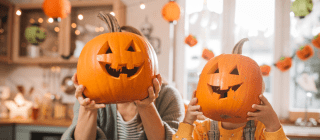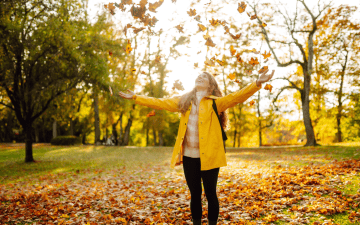Halloween Pumpkins Can Keep Nourishing You

Pumpkins are all around us in October. In this article, we share a roasted pumpkin seed recipe and the best ways to dispose of the gourd when it's time.
Colorful pumpkins carved into jack-o-lanterns lift our spirits during the Halloween season. But did you know they can also nourish your body long after the spooky holiday has passed? That’s because pumpkins can be easily composted, adding nutrients to your soil and helping you grow healthy vegetables in the future.
How to Compost Pumpkins
Pumpkins that have been painted or decorated with inorganic materials cannot be composted and must be placed in household trash, according to the Chittenden Solid Waste District in South Burlington. To keep your pumpkins from becoming trash, be sure to keep them free of:
- Glue
- Stickers
- Glitter
- Paint
- Wax
- Hairspray or petroleum jelly (sometimes used to extend a jack-o-lantern’s life)
Remember to remove any lights or candles that you’ve used before composting your pumpkins. Cutting pumpkins into smaller pieces will help them decompose more quickly.
If you have a backyard compost pile, you can add the pumpkin pieces to it and cover them with leaves or other organic matter. If you don’t have an established pile, put the pieces in your garden and cover them with a little soil or leaves. Next spring you can turn the decomposed pieces into the soil when preparing your garden bed.
If you don’t have space at home for composting, you can still keep your pumpkins out of the landfill. Some Vermont solid waste districts, including the Chittenden Solid Waste District, accept pumpkins that have not been painted or decorated in their compost collection bins. Check with your district or food scrap hauler to see if they accept pumpkins for composting.
Feeding Animals
Composting is not the only way to keep pumpkins out of the landfill. They have several other uses, including:
- Livestock feed. Pigs, chickens, goats, sheep, and cows all love to eat pumpkins. Be sure that pumpkins are not painted or decorated and are free from mold before feeding them to animals, as mold can make them sick. Some farmers will accept pumpkin donations, including ones that have been carved.
- Bird feeders. To turn an uncarved pumpkin into a bird feeder, cut it in half, hollow out the center, and push a couple of sticks through it until they poke out the other side. Tie string on the sticks to hang the pumpkin from a tree branch and fill the center with bird seed. This video shows how to do it.
- Wildlife food. Squirrels, raccoons, deer, moose, foxes, and mice are among the critters that will feast on pumpkins left outside. Be sure that pumpkins have not been painted, as that is toxic to wildlife. Place pumpkins you are leaving out for wildlife well away from your house, to avoid attracting unwanted visitors to your yard.
Roasted Seed Recipe
When you are carving your jack-o-lantern, don’t toss the seeds. They can be roasted to make a healthy and delicious snack.
After scooping out the center of your pumpkin, use a spoon to separate as many of the seeds as possible from the pulp. Rinse the seeds using a colander. Some people like to boil the seeds in salt water for 10 minutes before roasting them.
Toss the seeds in melted butter or vegetable oil and a little salt, and then spread the seeds in a single layer on a baking sheet. You can line the sheet with parchment paper to make clean up easier. Roast in a 300-degree oven for 45 minutes or until golden brown. Store the roasted seeds in an airtight container. They can be kept at room temperature for up to two weeks or in the refrigerator for up to two months.
For Halloween safety tips, check out our blog article.



